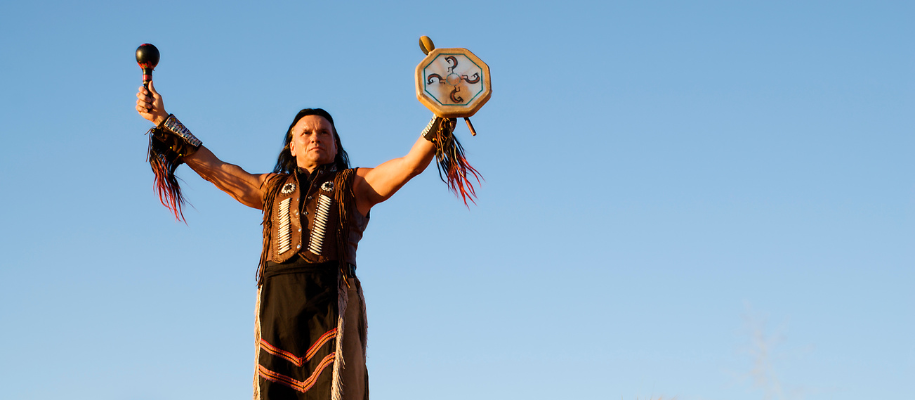Happy Native American Heritage Month! To round out the month-long celebration, in part two of our Native American Heroes of History series, we’ll unravel the tales of Indigenous chiefs and warriors who fought to protect their sacred ancestral lands and their people from encroaching white settlers.
Black Kettle
Black Kettle—nicknamed Motavato or Moke-ta-ve-to—was born near the Black Hills of South Dakota in 1803. After making his way south, he joined the Southern Cheyenne tribe in 1832 before going on to become chief of the Wuhtapiu group of the Cheyenne in 1861. For many years, Black Kettle and his people prospered in the vast territory of western Kansas and eastern Colorado, which was guaranteed to the Cheyenne under the Fort Laramie Treaty of 1851. However, prior to becoming chief, the 1859 Pikes Peak gold rush sent settlers flooding in. Instead of upholding the Fort Laramie Treaty, the government commanded the Southern Cheyenne to sign a new treaty—ceding all their lands except the small Sand Creek reservation in southeastern Colorado.
Black Kettle reluctantly agreed to the treaty in 1861. However, the Sand Creek reservation was barren—making it impossible to farm on it—the closest herd of buffalo was over 200 miles away, and the reservation was overrun with disease. Desperate young Cheyenne braves began to leave the reservation in hordes, killing livestock of nearby settlers and stealing supplies from passing wagon trains and mining camps to the west. The victims of the robberies and attacks soon formed a volunteer militia, which led to the Colorado War of 1864–1865 and one of the most infamous incidents of the Indian Wars: the Sand Creek Massacre, in which roughly 150 Native Americans were killed.
In October 1865, Black Kettle signed the Little Arkansas Treaty, in which US government offered reparations for the Sand Creek Massacre but also exchanged the two Sand Creek reservations for a new reservation. Many of Black Kettle’s people refused to obey the treaty and instead ventured north to join the Northern Cheyenne in Lakota territory. When the US Government sent in General William Tecumseh Sherman to force the Cheyenne onto their assigned lands, attacks ensued. After years of attacks, the government concocted the Medicine Lodge Treaty of 1867, which moved the Cheyenne yet again—onto two smaller reservations in the Indian Territory. Members of the Cheyenne, the Dog Soldiers, continued to raid farms in Kansas and Colorado until yet another campaign was launched against the Cheyenne encampments—including Black Kettle’s village.
Commander Custer ordered an attack on the village on November 27, 1868. Though a white flag flew above Black Kettle’s tipi, both he and his wife were killed, along with approximately 150 warriors and about 20 civilians. By the following year, the remaining Cheyenne were driven to reservations. Until the bitter end, Black Kettle was a peaceful chief, only ever doing what he hoped would be best for his people.
Related: College Search Q&A: Partnership With Native Americans
Chief Pontiac
Chief Pontiac was born circa 1720 on the Maumee River (in present-day Ohio). Little is known of Pontiac’s early life, but by 1755, he was an Ottawa war chief and an inter-tribal leader among the Ottawa, the Potawatomi, and the Ojibwa. In 1760, Pontiac met British colonial ranger Major Robert Rogers on his way to occupy Michilimackinac and other forts surrendered during the French and Indian War. Chief Pontiac allowed the British troops to pass through ancestral lands unharmed on one condition: he and his people were to be treated with respect. However, under British rule, Pontiac and his people were no longer welcome in the forts—and eventually, ruthless white settlers would overrun their ancestral lands and deprive the tribe of their hunting grounds. In 1762, Pontiac rallied every tribe he could—from Lake Superior to the lower Mississippi—in the hopes of evicting the British. The battles would become known as Pontiac's War. Pontiac made it his mission to capture Detroit himself, but his plans for an ambush had leaked to the British, and he had no choice but to lay siege to the fort.
In an attempt to break Pontiac's siege of Fort Detroit, approximately 250 British troops attempted an ambush on Pontiac's camp. But Pontiac and his people defeated the British at Parent's Creek. On July 31, Pontiac reigned victoriously, but British reinforcements made their way to Fort Detroit regardless, forcing Pontiac to withdraw to the Maumee River on October 30, 1763. Of the 12 fortified posts attacked by Pontiac and his confederacy of tribes, all but four were captured—but violence and unrest continued. In July 1766, Pontiac met with the British Superintendent of Indian Affairs at Fort Ontario in Oswego, New York, and signed a peace treaty. Pontiac’s entire life was dedicated to protecting his people and their land, but just three years later, a Peoria Indian stabbed and killed him in Illinois. Historian Francis Parkman alleges in his book that Pontiac’s murder sparked a war of vengeance against the Peoria people, but no evidence exists to confirm it.
Victorio
Victorio was born on the Black Range of New Mexico in the 1820s and raised as a member of the Chihenne (or Tchihendeh) Apache tribe. He’s believed to have been part Mexican, and his sister was a famous warrior woman, “Dextrous Horse Thief.” He became a warrior and the chief of the Warm Springs band and a large mixed band of Mimbreños and Mescaleros, and he was fiercely loyal to his land and his people.
In the summer of 1872, the US Army moved the Chihennes to the Tularosa Reservation, more than 50 miles to the west of their sacred homeland. The Chihenne pleaded with policymakers to let them go home. Two years later, the US government relented and established a Chihenne reservation at Ojo Caliente, allowing the Chihenne to return to their sacred homeland. But in 1877, the government set out to herd all of the Apache bands to San Carlos. Victorio and many others refused and began making their way back home, but army patrols were in hot pursuit. Victorio eventually surrendered at Fort Wingate.
Back at Ojo Caliente, the Chihennes—still prisoners of war—patiently waited to hear if they’d be allowed to stay in their homeland. In 1879, after two long years of waiting, Victorio’s war began. He led a series of battles against troops of the 9th, 10th, and 6th US Cavalry. In April 1880, Victorio led a raid on settlers' homes around Alma, New Mexico; it was known as the Alma Massacre. After many more attacks, the Mimbreños and Mescaleros succeeded in forcing the US soldiers to retreat, and Victorio carried on but was intercepted at Quitman Canyon in July 1880. Over 4,000 9th, 10th, and 6th US Cavalrymen, along with the 15th US Infantry and Texas Rangers, chased after Victorio—but he dodged and fooled them all again and again.
In October 1880, Victorio and his band were surrounded and killed by Colonel Joaquin Terrazas and the Mexican Army in the Battle of Tres Castillos. Though an 1886 appendix for Papers Relating to the Foreign Nations of the United States indicates that Victorio was killed by Mauricio Corredor, a Tarahumara Scout, the Apache believe that Victorio committed suicide rather than face capture.
Related: Native American Scholarships: 3 Steps for a Better Search
Chief Ouray
Chief Ouray—meaning “arrow” in the Ute language—was born near Taos, New Mexico, in 1833. His father was Jicarilla Apache, another chief of the Ute. His mother was a member of the Uncompaghre Ute band. He didn’t grow up with his parents but was raised by a neighboring Spanish and educated by Catholic friars. By his teens, he could speak Spanish, Ute, Apache, and some English. Ouray’s young life was spent working with Mexican sheepherders and honing his skills as a warrior. When he was 17, Ouray joined his parents in Colorado. He was chief of the Uncompahgre Ute Tribe by age 35. Ouray was adamant that peaceful coexistence with the growing number of white settlers in the area was necessary for his people’s survival. To promote this, Chief Ouray met with Presidents Lincoln, Grant, and Hayes, eventually being named “Ouray, the Head Chief for all the Ute tribes,” “the white man’s friend,” and “the man of peace” by his government contacts. Ouray negotiated several treaties over the years in an attempt to preserve the Ute’s ancestral lands. But promises made were not promises kept, and the Ute people grew weary of Ouray’s peaceful approach.
The Meeker Massacre of 1879 (also known as the Meeker Incident) only worsened relations between the Ute and the US government. Not understanding or respecting the Utes’ traditional way of life, Nathan Meeker tried to force the nomadic hunters and gatherers to farm, pulling in military assistance to make it happen. The Utes revolted on September 29; they killed Meeker and 10 others and took Meeker’s family hostage. Articles were published and politicians campaigned on the slogan, “The Utes Must Go!” When Ouray caught wind of the massacre, he pleaded for the warriors to retreat and release their hostages. They released them to Ouray and his wife, Chipeta, who cared for them at their home.
Ouray and Chipeta went to Washington, DC, in 1880 to meet with government officials to concoct the final treaty for the Utes. The treaty declared there would be a massive reservation on Colorado’s Western Slope created for the Ute in exchange for surrendering the Central Rockies to the US government. Not long after, Ouray succumbed to Bright's disease in August of 1880. After his death, the Denver Post printed of him, "Ouray was a friend of the white man and protector to the Indians."
Related: Native American Heroes of History: 5 Incredible People
Is this the first you’ve heard of these Native American heroes? It’s time they became household names! We hope you’ve enjoyed learning more about Native American heroes, traditions, and culture with us this month. We also hope you continue to educate yourself and others on these incredible people and how they’ve shaped history. Happy Native American Heritage Month!
Find more content about and for Indigenous peoples using the tag "Native American Heritage Month." You can share it with your network and spread the word all year round.







